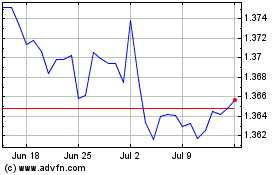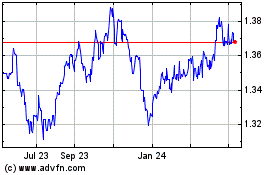Pound Rises After U.K. CPI Data
April 11 2017 - 1:38AM
RTTF2
The British pound strengthened against the other major
currencies in the European session on Tuesday, after data showed
that the U.K. consumer prices rose more-than-expected in March.
Data from the Office for National Statistics showed that the
U.K. core consumer prices rose 0.4 percent in March, slightly
faster than the expected 0.3 percent. On yearly basis, the consumer
price index including owner occupiers' housing costs also climbed
2.3 percent in March.
Meanwhile, inflation held steady at 2.3 percent in March, in
line with expectations. This was the highest rate since September
2013. Another report from ONS showed that factory gate inflation
slowed slightly in March. Output prices grew 3.6 percent annually,
following a 3.7 percent rise in February. This was the ninth
consecutive annual growth in prices.
On month, factory gate price inflation doubled to 0.4 percent
from 0.2 percent in February.
Input price inflation slowed to a 3-month low of 17.9 percent in
March from 19.4 percent in February. Economists had forecast prices
to advance 17 percent.
On a monthly basis, input prices climbed 0.4 percent, in
contrast to February's 0.1 percent drop.
Ahead of these data, the pound fell as heightened geopolitical
risks in the Middle East and the Korean Peninsula coupled with
uncertainty over France's upcoming presidential election sapped
investors' appetite for risk.
North Korea denounced the U.S. deployment of a navy strike group
to the Korean peninsula, warning it was ready for "war" in a
further escalation of tensions.
Separately, U.S. President Donald Trump and British Prime
Minister Theresa May have agreed there is a "window of opportunity"
to persuade Russia to break ties with Syrian President Bashar
Al-Assad.
Trump is open to authorizing additional strikes on Syria if the
regime uses chemical weapons again or deploys barrel bombs in the
country, the White House had said on Monday.
In France, polls show that voters are increasingly more divided
and disappointed with politics ahead of the first round of voting
in France's presidential election on April 23.
In the Asian trading today, the pound was trading higher against
its major rivals.
In the European trading, the pound rose to a 4-day high of
1.2444 against the U.S. dollar, from yesterday's closing value of
1.2403. The pound may test resistance around the 1.26 region.
The pound advanced to 137.71 against the yen, from an early
4-day low of 137.11. On the upside, 140.00 is seen as the next
resistance level for the pound.
Against the euro and the Swiss franc, the pound edged up to
0.8520 and 1.2529 from early lows of 0.8542 and 1.2497,
respectively. This may be compared to an early 5-day high of 0.8517
against the euro and a 4-day high of 1.2540 against the franc. If
the pound extends its uptrend, it is likely to find support around
0.84 against the euro and 1.27 against the franc.
Looking ahead, U.S. NFIB small business index for March is
slated for release in the New York session.
At 1:45 pm ET, Federal Reserve Bank of Minneapolis President
Neel Kashkari is expected to speak at the Minnesota Business
Partnership, in Minneapolis.
US Dollar vs CAD (FX:USDCAD)
Forex Chart
From Mar 2024 to Apr 2024

US Dollar vs CAD (FX:USDCAD)
Forex Chart
From Apr 2023 to Apr 2024
